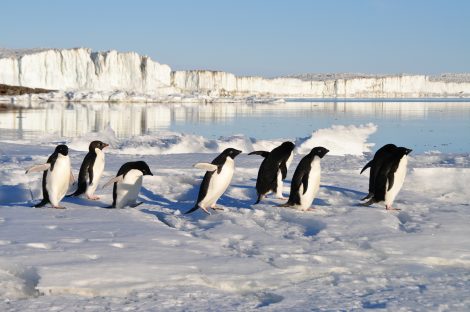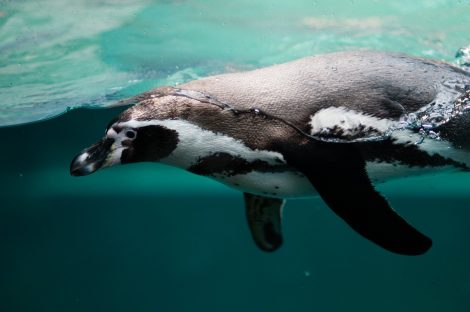On the first look, it is easy to say if an animal is a bird, amphibian, or terrestrial. But people often get confused when they look at penguins. The first question to pop up in anyone’s mind after seeing penguins might very well be - what are penguins? Penguins look like birds, but they spend a lot of time in the water. They stand upright on two legs and also hop on their feet to get from one place to another. If we go by the biological definition, penguins are defined as marine birds.
These flightless birds are found in the southern hemisphere and out of the 17 species of penguins, only a few are found farther from the cold regions of Antarctica. Africa’s jackass penguins and New Zealand’s fairy penguins are able to live in these locations because of the presence of cold waters near the island where these penguins live. Galapagos penguins are a popular species of penguins because they live in Galapagos islands that are close to cold water currents which are crucial for the survival of penguins.
The biggest penguins of all, Emperor penguins live in the cold regions of Antarctica and they form large colonies in order to breed, lay eggs, and incubate their eggs. Scientists have estimated there are about 46 colonies of Emperor penguins in the Antarctic region and about 595,000 adult penguins are living in the region.
Penguin Diet - Penguin diet consists mainly of fish and krill. Some penguins also eat crustaceans and small squid to make up for lack of availability of their preferred fish. In captivity, penguins will eat the fish that is given to them, and their caretakers often include required vitamins in their diet by adding it with their fish.
Penguins are Carnivores that Eat Fish and Krill by derdento / Pixabay License
Penguins can also drink salt water as they have glands near their eyes to remove salt from the water. They sneeze out the salt that is removed from the water. As penguins do not have teeth, they swallow the fish whole and digest the fish in their stomach acids. Their tongues have hooked barbs on them that prevent the fish from coming back up.
Mating Habits of Penguins - Emperor penguins stay with the same mate every season and change mates only in the case their mate fails to reach the colony or if their mate has died. They have elaborate mating rituals where an emperor penguin will find a place to create a nest and then invite the female over to inspect the nest. Once the female has examined the nest and found it to her satisfaction, she will touch beaks and flippers with the male penguin. The male penguin will squawk loudly to tell other penguins that he has found a mate.
Most penguins lay two eggs in a season, but emperor and king penguins are known to lay only one egg each breeding season. The duties of incubation fall solely on the shoulders of the male emperor penguin. Once the female has laid the egg, the male penguin will incubate the egg for anywhere from a few weeks to two months when he will not eat anything. The female will return to the same spot after two months so that the male can leave and feed himself. The responsibility of rearing the chicks falls on both male and female penguins.
Penguins Come In DIfferent Sizes - The biggest penguin is rightly named Emperor penguins and they can reach anywhere 1.1 m and the smallest penguins, the fairy penguins can measure close to 40 cm. In general, penguins closer to the equator are smaller in size while penguins closer to Antarctica are larger.
One reason for this could be that penguins in colder region have a layer of blubber and feathers on their body that is essential for their survival. While penguins that live closer to the equator don’t need the additional fat on their body as they don’t have to face the low temperatures of the Antarctic region.
Penguins are Exceptional Swimmers - Due to the shape of their body and the fact that penguins spend most of their time in the water, they are really good swimmers. Large penguins like emperor penguins and king penguins can dive deep into the sea to look for food. Penguins are known to hold their breath for as long as 20 minutes when they are diving, and they can also divert blood to their vital organs so that they can remain functional while diving.
Penguins are Exceptional Swimmers by PublicCo / Pixabay License
Penguins have strong flippers that they move in a flying motion under the water to move forward. They also tuck their neck close to their body and use their tail as a rudder when swimming. When exiting the water, penguins vibrate their feathers quickly to release the air bubbles trapped close to their skin so that they can exit the water with a powerful jump and avoid getting caught by any predators.
Penguins Have Natural Camouflage - With their dark backs and light front, penguins are best equipped to hunt in water. When they swim in the water, they look like the bottom of the sea to the predators above and the light coloring on their front makes them look like a part of the sky to the predators in the sea. This allows penguins to escape many kinds of dangers from other animals when they are hunting for fish or krill in the sea.
Penguin Endangerment Status - Out of the 17-19 species of penguins several are considered as endangered or under consideration regarding their conservation status. Human activities such as excessive fishing, oil leaks, and global warming impact penguins as their food supply gets affected and this in turn affects the survival of the future generations of penguins. As penguins spend more time at sea to look for food, they are not able to feed their chicks on time which results in death or starvation of the chicks.
Penguins trapped in oil leaks are not able to swim or hunt for food and they are dependent on rescuers for cleanup and release into the ocean again. As global warming reduces the ice cover in the Antarctic and the water temperatures increase, it can be a negative effect on the overall health of the penguins.
Conclusion
Hopefully, by now you know a lot about penguins and how these wonderful creatures are a unique addition to the ecosystem of the planet. Penguins have a cute and cuddly image in the media and they are portrayed as innocent in movies or culture, but these animals are smart, wonderful, and have unique personalities.
Today, penguins face great risk from human activities, and the impact of these activities is going to make it difficult for penguins to survive in the coming future. The more information that is out there about these marine-birds, the better the chance of their survival so that our future generations can see these birds in their natural habitat.
If you have any questions or queries about what are penguins, please free to discuss in the comment section and our team will answer to the best of their abilities.
References
https://defenders.org/penguins/basic-facts

